The Role of Bumble Bee Flowers in Biodiversity
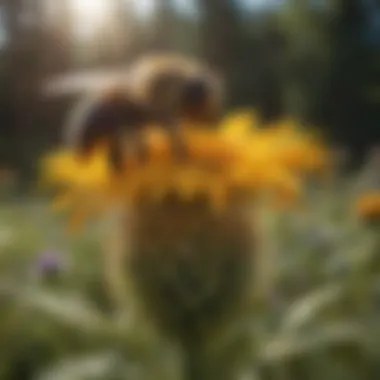

Intro
Understanding the relationship between bumble bees and flowering plants is essential for recognizing their significance in biodiversity. Flowers provide critical resources such as nectar and pollen, which bumble bees need for food and reproduction. As bumble bees interact with various floral species, they facilitate pollination processes that contribute to plant diversity and health. This symbiotic relationship plays a vital role in maintaining balanced ecosystems, particularly in woodland areas.
Understanding Woodland Ecosystems
Importance of Biodiversity in Forests
Woodland ecosystems represent complex networks of life, where numerous species co-exist and interact. The diversity of plants, animals, and microorganisms supports various ecological functions. Biodiversity in these ecosystems leads to greater resilience against environmental disturbances, such as climate change or diseases. Specifically, flowering plants attract bumble bees, which are key pollinators. Their activities promote the reproduction of many tree and shrub species, ultimately enhancing the overall diversity of the forest.
Role of Forests in Climate Regulation
Forests act as crucial carbon sinks by absorbing carbon dioxide during photosynthesis. By maintaining diverse floral communities, forests optimize their ability to sequester carbon. This, in turn, supports climate regulation. The presence of bumble bee-friendly flowers contributes to the stability of ecosystems. Protecting these plants is crucial not just for the bumble bees, but also for broader environmental health.
Key Insight: "Pollinators like bumble bees are indispensable for the health of woodland ecosystems, significantly affecting plant diversity and ecosystem services."
Sustainable Forestry Practices
Principles of Sustainable Forestry
Sustainable forestry aims to balance economic needs with ecological integrity. This practice involves several principles:
- Ecosystem-based management: Assessing impacts on entire ecosystems, including flora and fauna.
- Conservation of biodiversity: Protecting species that contribute to ecosystem health.
- Preservation of habitat: Ensuring that habitats for pollinators are maintained during forestry activities.
Integrating bumble bee conservation within these principles underscores the necessity of preserving flowering plants in woodlands.
Case Studies of Successful Implementations
There are several notable examples where sustainable forestry has successfully included bumble bee conservation:
- The Forest Stewardship Council (FSC) promotes practices that protect pollinator species.
- Various programs in Scandinavia have adopted habitat-enhancing measures to support bumble bee populations.
Such initiatives highlight the importance of aligning forestry practices with the needs of bumble bees and their flowers.
Woodland Stewardship Techniques
Forest Management Plans
Effective forest management plans incorporate strategies tailored to conserve bumble bee habitats. This includes:
- Selective harvesting to minimize habitat disruption.
- Planting native flowering species that serve as bumble bee forage.
- Monitoring bumble bee populations to assess ecosystem health.
Conservation Strategies
To protect bumble bees and their floral supports, various conservation strategies are essential:
- Creating pollinator-friendly spaces in woodlands, where floral diversity is prioritized.
- Engaging local communities in conservation efforts to raise awareness about the importance of bumble bees.
Foreword to Bumble Bees
Understanding bumble bees is essential for comprehending the broader ecological narrative of flowering plants and their role in supporting biodiversity. As key pollinators, bumble bees provide significant contributions to the health of ecosystems. Their interactions with various flora directly affect the reproduction of many plants, influencing wider biodiversity.
This section sets the stage for the discussion ahead by defining what bumble bees are and explaining their crucial role within ecosystems.
Defining Bumble Bees
Bumble bees belong to the genus Bombus within the family Apidae. These insects are characterized by their robust bodies, fuzzy appearance, and often vibrant color patterns. Unlike honey bees, bumble bees are generally larger and tend to have a shorter life cycle. The colony structure is also different; bumble bee colonies are typically smaller and do not survive the winter, as only the new fertilized queens hibernate.


Bumble bees are social insects, living in groups that consist of a queen, workers, and males. The queen is responsible for laying eggs, while the workers foraging for nectar and pollen. Since they can regulate their body temperature, bumble bees can forage in cooler temperatures and lesser sunlight than other pollinators, making them unique in their adaptability.
Significance in Ecosystems
The significance of bumble bees in ecosystems cannot be overstated. They play a pivotal role in pollination. Many flowering plants rely on bumble bees for reproduction. Some key points to consider include:
- Pollination Efficiency: Bumble bees have specialized body structures that can transfer pollen effectively. Their foraging habits promote cross-pollination, which enhances genetic diversity in plants.
- Support for Food Webs: The availability of diverse plants helps sustain various species, including birds, insects, and mammals, which depend on these plants for food and habitat. Bumble bees, therefore, are essential in maintaining balanced ecosystems.
- Economic Importance: Many crops and wild plants that depend on bumble bee pollination are critical for agriculture. The economic value of these ecosystem services is substantial, supporting food production and job creation.
- Indicator Species: Bumble bee populations can serve as indicators of ecological health. Their presence and abundance reflect the broader condition of the environment, signaling changes in habitat quality and biodiversity.
"Bumble bees are not just flying insects; they are vital cogs in the ecological machinery that supports life on Earth."
In summary, understanding bumble bees offers insight into the intricacies of ecological balance and the importance of flowering plants in sustaining biodiversity. Their role extends beyond mere pollination; they are harnessers of nature’s interconnected web.
Overview of Bumble Bee Pollination
Bumble bees play a pivotal role in the pollination of various flowering plants within our ecosystems. They are responsible for transferring pollen from one flower to another, which is crucial for the reproductive success of many plant species. Understanding this role helps underscore the interconnectedness of species in the environment, particularly how bumble bees and flowers work together to sustain biodiversity.
Role as Pollinators
Bumble bees are among the most efficient pollinators in nature. Unlike many species that simply collect nectar, their size and behavior allow them to effectively disperse pollen, leading to improved fertilization and fruit production in plants. Their fuzzy bodies collect pollen as they move from flower to flower, ensuring that the transfer is both plentiful and effective.
The process of buzz pollination is another important aspect of their role. Bumble bees can vibrate their wings at a specific frequency, which helps release pollen from certain flowers, such as tomatoes and blueberries. This unique ability is crucial for maximizing the reproductive output of these plants. As they forage for food, bumble bees inadvertently become the key links in maintaining plant diversity and abundance in their habitat.
Impact on Flora and Fauna
The act of pollination does not only benefit the plants but also the wider ecosystem at large. When bumble bees pollinate flowering plants, they facilitate the growth of fruits and seeds that serve as food for other species. For example, various birds and small mammals depend on berries and seeds produced by flowering plants. Thus, bumble bees indirectly support entire food webs that rely on plant diversity.
Moreover, the stability of entire ecosystems often hinges on the health of pollinator populations such as bumble bees. A decline in their numbers can lead to reduced flowering plant populations, impacting not just the immediate flora but also the fauna that depend on those plants. The ongoing decline of bumble bee populations due to habitat destruction, pesticide use, and climate change can set off a chain reaction, threatening biodiversity across multiple levels of the ecosystem.
"The health of pollinator species such as bumble bees is directly linked to the stability of our ecosystems, emphasizing their vital role in supporting biodiversity."
Essential Bumble Bee Flowers
The connection between bumble bees and their preferred flowers is a critical one for sustaining biodiversity. Bumble bees require specific types of flowers not only for food but also to support the ecological balance in their habitats. These relationships are essential for ensuring a stable ecosystem where both flowers and bumble bees can thrive. Understanding the essential flowers for bumble bees helps in implementing conservation strategies aimed at maintaining both plant and pollinator populations, which ultimately supports broader biodiversity.
Characteristics of Preferred Flowers
Bumble bee flowers possess distinct characteristics that make them attractive and accessible to these pollinators. One key feature is the shape of the flowers. Flowers that are tubular or have an open landing platform attract bumble bees more readily. These shapes allow for easier access to nectar and pollen, which are the primary resources these insects seek.
Another important characteristic is the color of the flowers. Bumble bees are more attracted to flowers that are blue, purple, and yellow. These colors stand out in the natural environment, making them easier for bumble bees to locate. Flowers that bloom in succession are also vital, as they provide a continuous food source throughout the foraging season. This ensures that bumble bee populations can find sustenance even when certain floral species are not in bloom.
Types of Flowers Favored by Bumble Bees
Wildflowers
Wildflowers are a critical resource for bumble bees and play a significant role in supporting their populations. These flowers often grow in less disturbed habitats, providing essential nutrients and sustenance. Wildflowers bloom at various times, ensuring that bumble bees have access to food throughout the seasons.
A key characteristic of wildflowers is their diversity. This diversity not only meets the nutritional needs of bumble bees but also supports various other insect species, thereby promoting an overall rich ecosystem. A disadvantage could be that some wildflower habitats are under threat due to urbanization and agriculture, which limits their availability.
Garden Plants
Garden plants serve as an important food source for bumble bees within urban settings. Home gardens often include a mix of flowering plants that can easily attract these bees. A significant aspect of garden plants is that they can be cultivated deliberately to ensure bumble bees have access to resources.
These plants often provide reliable blooms, making them a consistent source of nectar and pollen. However, the downside is that non-native garden plants may not always support local bee populations as effectively as native varieties do, which could inhibit some of the ecological benefits.
Native Flora
Native flora is particularly beneficial for bumble bee populations. These plants have co-evolved with local bee species and are ideally suited to support them. Native flora generally requires less maintenance and promotes local biodiversity. A key characteristic is that they provide food sources that are more compatible with the nutritional needs of bumble bees.
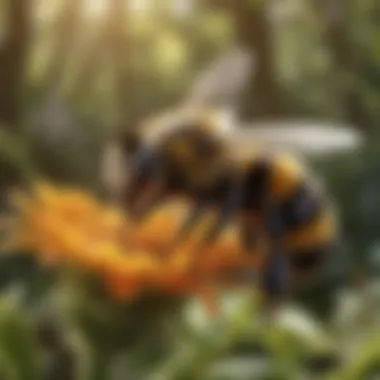
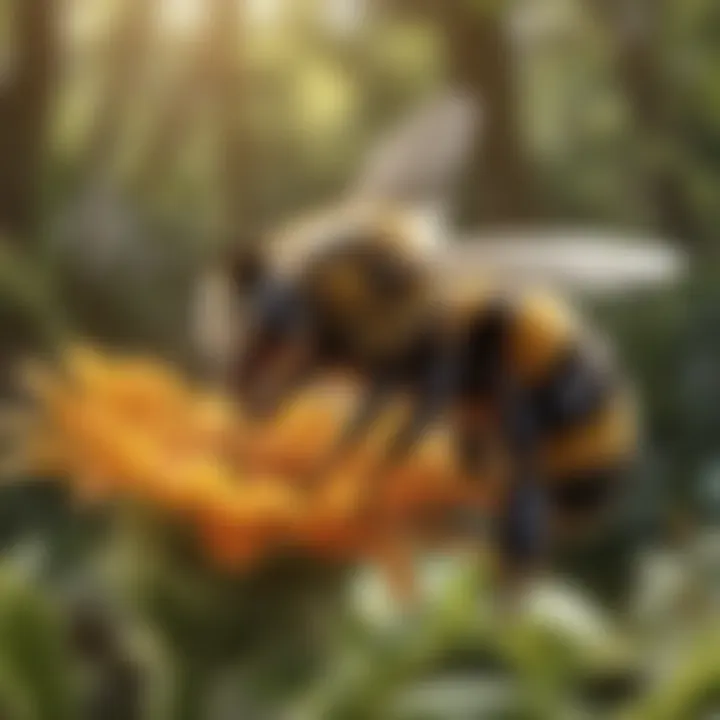
One unique feature of native flora is its resilience to local climate conditions, which helps sustain bumble bees through environmental changes. The disadvantage might be the limited availability of certain native plants, particularly in highly modified landscapes.
"Ecosystems enriched with diverse flowering species play a vital role in bolstering bumble bee populations, which in turn sustain a myriad of environmental benefits."
Overall, understanding the role of essential bumble bee flowers is important for conservation efforts. Promoting both native wildflowers and suitable garden plants can help maintain healthy bumble bee populations, which is vital for ecological stability.
Impact of Biodiversity on Bumble Bee Populations
Biodiversity plays a crucial role in maintaining the populations of bumble bees. The rich tapestry of plant life directly influences not only the habitats of these insects but also their survival and reproductive success. A high level of biodiversity offers varied sources of nutrition and nesting sites for bumble bees, which are essential for their ecological role. This complex interaction between bumble bees and their floral resources illustrates a fundamental aspect of ecosystem dynamics.
Ecosystem Stability
A diverse ecosystem contributes to stability, which is paramount for sustaining bumble bee populations. When various plant species coexist, it creates a more resilient environment. This resilience helps buffer against environmental stressors such as disease outbreaks, extreme weather conditions, and habitat degradation. Bumble bees thrive in stable ecosystems that can support their foraging and nesting requirements.
Key benefits of ecosystem stability include:
- Diverse Foraging Options: The presence of multiple flowering plants allows bumble bees to find food year-round. This is essential for their survival, especially during times of scarcity.
- Improved Pollination Efficiency: Higher biodiversity fosters effective pollination across various plant species. In turn, this enhances the overall productivity of ecosystems.
- Nesting Choices: Bumble bees often require specific habitats for nesting, such as old logs, grass tussocks, or leaf litter. A biodiverse environment increases the availability of these habitats.
Thus, maintaining and promoting biodiversity is critical. The decline of specific floral species can lead to a corresponding decrease in bumble bee populations, impacting not only these insects but other species that rely on them for pollination.
Food Sources and Nutrition
Bumble bees have specific dietary needs that demand a range of floral resources. A diverse array of flowers ensures they have access to necessary nutrients, such as proteins, carbohydrates, and vitamins. This variety is particularly important during different life stages of bumble bees.
- Proteins and Lipids: These are crucial for developing larvae. Flowers such as clover and sunflowers are excellent sources.
- Carbohydrates: Nectar is the primary energy source. Bumble bees get this from a wide range of plants including fruit trees and wildflowers.
- Vitamins: The pollen from various flowers contributes to a balanced diet, necessary for the health of adult bees and their offspring.
The reliance on diverse food sources makes bumble bees vulnerable to monoculture practices. If landscapes are dominated by a single type of crop, the lack of variety can harm bee populations. Conversely, encouraging a rich mixture of flowering plants supports healthier and more robust bumble bee communities.
"In essence, the relationship between bumble bees and flowering plants is not just beneficial; it is essential for sustaining biodiversity itself."
Threats to Bumble Bees and Their Flowers
Bumble bees play a vital role in many ecosystems, specifically through their interactions with flowers. Understanding the threats they face is crucial for effective conservation efforts. This section discusses three primary threats: habitat loss, pesticide and chemical use, and climate change effects. These factors significantly disrupt the balance that bumble bees maintain within ecosystems.
Habitat Loss
Habitat loss is one of the foremost challenges bumble bees encounter. Urban development, agricultural expansion, and deforestation contribute to the fragmentation of their natural habitats. As forests and wildflower meadows are replaced with buildings or monoculture farms, bumble bee populations decline due to reduced access to food sources. When their habitats are destroyed, the variety of flowers they rely on diminishes. This creates a ripple effect, reducing food availability for bumble bees and disrupting their life cycles.
Furthermore, habitat restoration efforts often focus on a few select species, overlooking the need for ecological diversity. It's essential to maintain not only the presence of bumble bees but also the intricate web of plants and flowers that supports them. Protecting existing habitats and restoring degraded areas can significantly aid in rebuilding bumble bee populations in a sustainable manner.
Pesticides and Chemical Use
The use of pesticides poses another serious threat to bumble bees. Chemicals such as neonicotinoids can adversely affect their foraging behavior, reproductive success, and overall health. These pesticides not only kill individual bees but also disrupt whole colonies. Research indicates that exposure to pesticides can decrease lifespan and lead to reduced ability to gather nectar and pollen.
In addition to direct toxicity, the chemical landscape affects the flora bumble bees depend on. Pesticide application may kill flowering plants, leading to fewer resources for these pollinators. Thus, fostering practices that reduce or eliminate pesticide use will benefit bumble bees as well as the health of the entire ecosystem. Encouraging organic farming and alternative pest management strategies can help alleviate this risk.
Climate Change Effects
Climate change is an overarching threat impacting various dimensions of bumble bee survival. Changes in temperature and precipitation patterns alter the blooming periods and geographical distribution of flowers. Bumble bees and flowering plants are closely linked, and if flowers bloom earlier or later than usual, mismatches in timing can occur.
As temperatures rise, some bumble bee species may not be able to adapt quickly enough. This leads to population declines and potentially extinction. The shift in climate also changes habitats and makes it harder for certain plants to grow. When native flora is replaced by invasive species that bumble bees cannot utilize, their populations are further threatened.
"Conservation efforts must take into account the evolving landscape influenced by climate change to ensure the survival of bumble bees and their habitats."
The complexities of these threats require coordinated responses from communities and professionals dedicated to preserving biodiversity. Addressing these challenges involves multi-faceted strategies that prioritize both bumble bees and their vital flower resources.
Conservation Strategies for Bumble Bees
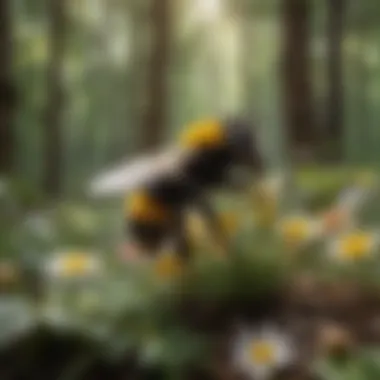
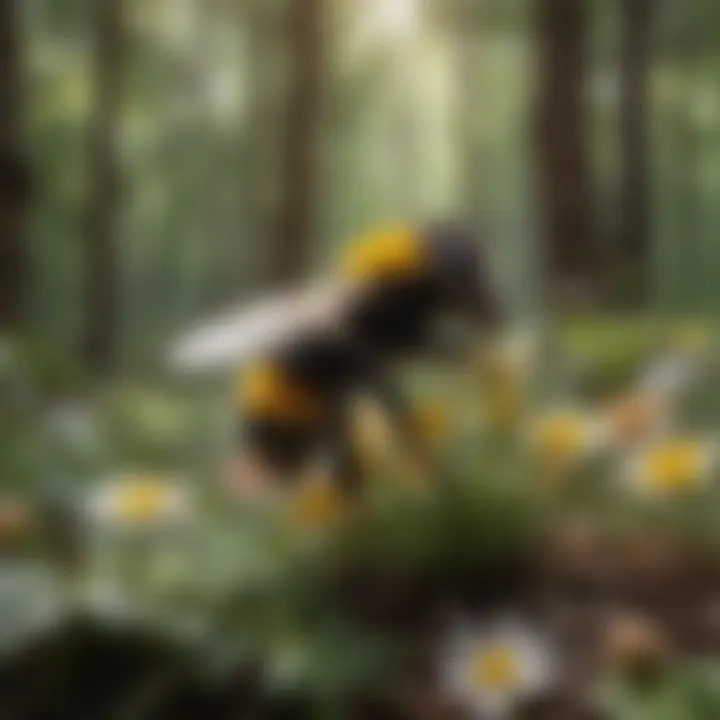
The conservation of bumble bees has become an urgent issue. Their survival is linked to the flowers they pollinate, which in turn supports entire ecosystems. Effective conservation strategies are necessary not only for protecting bumble bees but also for maintaining biodiversity. The decline of bumble bee populations raises concerns about plant reproduction and ecosystem health. By optimizing conservation efforts, we can make significant strides in preserving these vital species.
Creating Bee-Friendly Gardens
Creating bee-friendly gardens plays a crucial role in the conservation of bumble bees. These gardens provide essential habitats and food sources. Planting a variety of flowers that bloom at different times ensures that bumble bees have nectar and pollen throughout the growing season.
Some effective strategies include:
- Native Plants: Choose native species, as they are better adapted to local environments and provide resources for native bee species.
- Pollen-Rich Flowers: Incorporate flowers known for being rich in pollen, such as sunflowers and clover. This aligns with bumble bees' preferences.
- Avoid Chemicals: Minimize or eliminate pesticide use, as these chemicals can harm not just bumble bees but also other beneficial insects.
A bee-friendly garden not only enriches local biodiversity but also connects communities with nature. Residents in urban areas can contribute significantly to bee conservation through their gardening choices.
Restoration of Native Habitats
Restoring native habitats is another key strategy for bumble bee conservation. Natural habitats are integral for sustainable populations. They provide not only floral resources but also nesting sites for bees. Unfortunately, habitat loss due to urban development and agricultural practices has greatly impacted bumble bee populations.
Restoration can include actions such as:
- Replanting Native Flora: Reintroducing plants that are indigenous to the region supports local bumble bee species.
- Managing Existing Habitats: Preserving and managing existing ecosystems can help maintain their ecological integrity.
- Creating Corridors: Establishing habitat corridors can connect fragmented spaces, allowing bees to forage between different areas effectively.
These actions assist in creating a resilient environment, wherein bumble bees can thrive. Healthy ecosystems contribute to overall biodiversity, which is essential for ecological balance.
Community Engagement and Education
Community engagement is vital for successful bumble bee conservation. Awareness and education help people understand the importance of bumble bees and their role in ecosystems. Educated communities are more likely to participate in conservation efforts.
Key components of engagement include:
- Workshops: Organizing educational workshops on the importance of bumble bees and how individuals can contribute to their conservation efforts.
- Collaborations: Involving schools, local organizations, and community groups to foster a collective approach to conservation.
- Social Media Campaigns: Utilizing platforms like Facebook, Reddit, and Instagram to spread knowledge about bumble bee conservation.
Communities that work together can contribute significantly to reversing the decline of bumble bees. Collective efforts can lead to substantial improvements in local biodiversity, fostering not just a healthier ecosystem, but a stronger community bond as well.
"Bumble bees are not just important for pollination; their presence is a strong indicator of a healthy ecosystem. By engaging our communities, we can make a difference in their conservation."
The Future of Bumble Bee Populations
The future of bumble bee populations is critical for the biodiversity of many ecosystems. Bumble bees are key pollinators for a variety of plants, including many crops and wildflowers. As their populations continue to decline, it creates a ripple effect through food webs and ecosystems. Understanding how to sustain and support bumble bee populations is essential not only for their survival but also for the health of the ecosystems they inhabit.
Research indicates that factors such as habitat loss, climate change, and pesticide use significantly contribute to the decline of bumble bee populations. Addressing these challenges through targeted strategies can enhance the resilience of these species. It is vital to explore new research avenues that focus on the interaction between bumble bees and their environment, identifying which plants they are drawn to and understanding the changing dynamics of flora and fauna relationships.
Research Directions
Research is crucial for uncovering and addressing the challenges facing bumble bees. Areas of interest include:
- Genetic Studies: Exploring the genetic diversity within bumble bee populations can provide insights into their adaptability and resilience to environmental stresses.
- Ecological Modeling: Creating models to predict the impacts of climate change on floral availability and its subsequent effect on bumble bee behavior can guide conservation efforts.
- Pesticide Impact Studies: Investigating how different pesticides affect bumble bee health and their foraging behavior is essential in developing best practices that minimize harm.
- Floral Resource Mapping: Understanding which flower species bumble bees prefer and how this correlates to their foraging efficiency can inform habitat restoration projects.
These research initiatives can drive actionable policies and conservation strategies to safeguard both bumble bees and the ecosystems they support.
Policy and Regulation
The effective management of bumble bee populations necessitates comprehensive policy and regulatory frameworks.
- Habitat Protection Regulations: Implementing laws that protect natural habitats from development and degradation will preserve the environments that bumble bees rely on for survival.
- Pesticide Regulations: Stricter regulations on the usage of harmful pesticides, especially during flowering seasons, can reduce exposure and improve bumble bee health.
- Funding for Research: Allocating government and private funding towards research can stimulate innovations in bee conservation, creating new strategies to support declining populations.
- Community Involvement Policies: Engaging local communities in conservation efforts through education and advocacy can amplify the impact of policies targeting bumble bee survival.
Closure
The significance of understanding bumble bee flowers in relation to biodiversity cannot be underestimated. This article highlights the essential role that these flowers play not only in supporting bumble bee populations but also in maintaining the health of entire ecosystems. As bumble bees are crucial pollinators, the decline in their populations correlates directly with the deterioration of floral diversity. This creates a ripple effect impacting various species, compounding issues around food security and habitat stability.
Summary of Key Points
- Role of Flowers: Bumble bee flowers provide critical food sources necessary for the survival and reproduction of bumble bees, which are inextricably linked to the health of many plant species.
- Biodiversity Support: The availability of diverse flowering plants ensures that bumble bees have access to different types of nutrients, promoting genetic variability in their populations.
- Conservation Needs: Addressing the threats faced by bumble bees, including habitat loss and pesticide exposure, underscores the urgency for conservation strategies that prioritize preserving their floral resources.
- Future Implications: The state of bumble bee populations can serve as a barometer for broader ecological health, emphasizing the importance of both research and policy to bolster conservation efforts.
Final Thoughts on Conservation
Conservation efforts must focus on fostering environments that sustain diverse floral species. Educating communities about the interactions between bumble bees and plants can lead to better practices in gardening and land use. Restoration of native habitats is also vital in supporting these key pollinators. As biodiversity continues to face unprecedented pressures, safeguarding the relationships between bumble bees and their flowers will be crucial for maintaining ecological balance.







